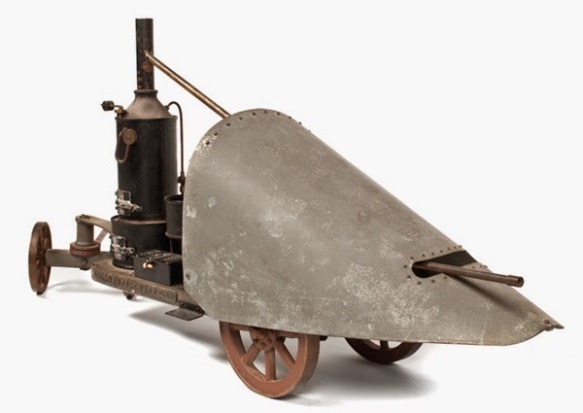This four-wheeled weapon is called Winan’s Steam Gun. According to the history of this weapon, The Winan’s Steam Gun can shoot 300 bullets in one minute. The half-coned metal acts as the armor for its machinery. It is very accurate and its bullet can go as far as a mile if not more. This weapon however, was not widely used around the world. It is believed to be because not many civilization were introduced to this invention. Winan’s Steam Gun was never introduced to anyone except its maker until it was seized by a Massachusetts’ volunteer on his way to a rebel camp. Though it looks funny and not well organized, this weapon firing shots using steam-powered technology is the main reason of its uniqueness.
Henry Clay Pate was a former attorney who, during the U.S. Civil War, organized a mounted company that was called Pate’s Rangers or the Petersburg Rangers. The innovative Pate designed the revolving cannon, which he had cast at the Petersburg foundry in Petersburg, Va. This cannon was then made available to Pate’s unit.
The cannon saw use in the siege of Petersburg, Va. It was captured by Union troops at Danville, Va, on April 27, 1865. While innovative, the weapon did not play a significant role on the battlefield. After its capture, the cannon was sent to the Ordnance Laboratory, United States Military Academy, West Point, New York.
Double-Barreled Cannon, Athens, Clarke County, Georgia
Among the numerous weird and wonderful inventions with which the Union, or the Confederacy, were to be saved, were several attempts to make repeating cannon on the revolver principle. Most of these never got beyond the testing stage and none ever saw action. The Scientific American illustrated many such during the first few months of the war. (Later the magazine, like many of its readers, became disenchanted with the seemingly endless struggle, and pictures of warlike gear gave way to woodcuts of cultivators and thrashing machines.) The majority of the rapid-fire cannon appear as unwieldly monstrosities, overdecorated with wheels and gears.
One relied on steam as a propellant; the “Justly celebrated Winans steam-gun which … was expected to revolutionize the then existing system of warfare,” was captured by Union General Ben Butler’s men in May of ’61. The wood engraving shows it as a fascinating-look contraption, part fire engine, part snowplow. It was obviously not up to revolutionizing warfare, or anything else, or the astute and unconventional Ben Butler, who would try anything if he thought it would work, would have made some use of it.
One of a pair of revolving cannons cast by Tappey & Lumdsen of Petersburg, Virginia for H. C. Pate (the other burst during its test firing and killed three of the crew) still can be seen outside a Petersburg museum. It is really not much more than a large revolver on wheels, with a crank at the back to force the cylinder forward against the barrel, to cut down leakage of gas.
Another “freak” gun still to be seen (this one at Athens, Georgia) is the famous double-barrel cannon. The device, which consists of two 6-pounder cannon cast in one piece so that they diverge slightly, is only the last of a long line of such pieces, designed to mow down the enemy like ripe grain, by two cannon balls connected by a chain. There is only one thing wrong with this delightful conception, as other enterprising artillerists have found out through the ages—it won’t work. No matter that the vents are drilled so as to give fire simultaneously to both barrels. No matter that the powder charges and balls are carefully weighed and that the chain is cunningly arranged. It is physically impossible to give both projectiles exactly the same momentum at exactly the same time. The results, as might have been foreseen, were spectacular, to say the least. A contemporary account says:
“It had a kind of circular motion, plowed up an acre of ground, tore up a cornfield, mowed down saplings, and the chain broke, the two balls going in opposite directions. One of the balls killed a cow in a distant field, while the other knocked down the chimney from a log cabin.”
